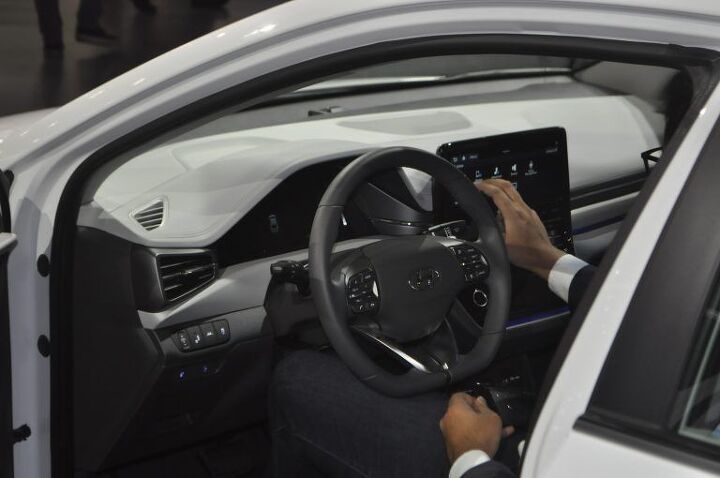2020 Hyundai Ioniq: Modest Changes, but the Electric Goes to War With Nissan

No one wants to come in last. With the Volkswagen e-Golf and Smart Fortwo EQ Electric Drive Whatever discontinued, Hyundai’s compact Ioniq Electric hatchback was poised to be the lowest-range electric vehicle in the North American market (minus, of course, the limited-availability, lease-only Honda Clarity EV).
Clearly, this looming position at the bottom of the ladder left a bad taste in Hyundai’s mouth. Preferring to see Nissan there, it set about making the necessary changes.
For 2020, the Ionic line, which encompasses a very thrifty hybrid, a plug-in hybrid, and an EV, undergoes some mild styling changes and adds the Hyundai SmartSense suite of safety features as standard equipment. There’s a revised grille and fascia (non-electrics get mesh), plus LED lamps fore and aft on uplevel trims, side sill moldings, and revamped wheel designs.
But you’re probably wondering how the Ioniq Electric, a low-priced green vehicle unlikely to grace the driveway of any TTAC reader, kicks Nissan’s ass. Well, for 2020 the model swaps its petite 28 kWh battery pack for a beefier 38.3 kWh unit. The swap elevates the vehicle’s driving range from a mediocre-at-best 124 miles to 170 miles, outclassing the base Nissan Leaf’s 151-mile range.
Unlike the Leaf, however, Ioniq buyers can’t shell out extra cash for a 226-mile “Plus” variant. Oh well. At least Hyundai can boast of its base EV offering more range. While Hyundai didn’t mention Ioniq Electric pricing, the 2019 model started at $31,245 after destination and before a $7,500 federal tax credit. That’s $330 more than a base Leaf S.
For the coming model year, the Electric also offers more grunt: 134 horsepower, compared to the previous 118 hp, though torque remains the same at 218 lb-ft. Charging speed also rises, from 6.6 kW to 7.2 kW, promising quicker battery top-ups. As for the Hybrid and PHEV, their powertrains remain unchanged.
Inside all Ioniqs, the newly upgraded 8-inch touchscreen (2019MY had a 7-inch) can be binned in favor of a 10.25-inch “widescreen” with navigation (see below), while the instrument panel also undergoes a revision. A new center LCD information screen joins the fray, as do touchscreen HVAC controls. Ambient lighting is customizable.
Hybrid buyers finally get the regenerative braking control paddles that eluded them up to this point.
As for safety, the SmartSense features include forward collision avoidance, lane-keeping assist, high beam assist, and driver attention warning. If road trips make you nervous, highway driving assist and lane following assist are optional.
Arriving in early 2017, the electrified Ioniq line hasn’t exactly set the sales charts on fire, though the past few months has seen the model’s volume increase noticeably. Year to date, Ioniq sales are up 33 percent.
[Images: Hyundai, Tim Healey/TTAC]

More by Steph Willems
Latest Car Reviews
Read moreLatest Product Reviews
Read moreRecent Comments
- 3-On-The-Tree Lou_BCone of many cars I sold when I got commissioned into the army. 1964 Dodge D100 with slant six and 3 on the tree, 1973 Plymouth Duster with slant six, 1974 dodge dart custom with a 318. 1990 Bronco 5.0 which was our snowboard rig for Wa state and Whistler/Blackcomb BC. Now :my trail rigs are a 1985 Toyota FJ60 Land cruiser and 86 Suzuki Samurai.
- RHD They are going to crash and burn like Country Garden and Evergrande (the Chinese property behemoths) if they don't fix their problems post-haste.
- Golden2husky The biggest hurdle for us would be the lack of a good charging network for road tripping as we are at the point in our lives that we will be traveling quite a bit. I'd rather pay more for longer range so the cheaper models would probably not make the cut. Improve the charging infrastructure and I'm certainly going to give one a try. This is more important that a lowish entry price IMHO.
- Add Lightness I have nothing against paying more to get quality (think Toyota vs Chryco) but hate all the silly, non-mandated 'stuff' that automakers load onto cars based on what non-gearhead focus groups tell them they need to have in a car. I blame focus groups for automatic everything and double drivetrains (AWD) that really never gets used 98% of the time. The other 2% of the time, one goes looking for a place to need it to rationanalize the purchase.
- Ger65691276 I would never buy an electric car never in my lifetime I will gas is my way of going electric is not green email





































Comments
Join the conversation
"...a low-priced green vehicle unlikely to grace the driveway of any TTAC reader" I have one (in blue, a 2019), and I don't even live in a CARB state. In the past year I've driven it 14k trouble-free miles. The first maintenance expense was a set of wipers this week. It's added maybe $30 to my electric bill each month. Range has been fine, with anxiety only a couple times when I know I've been pushing it. This car is way better than my 12 Leaf was, and IMO, when I test drove an 18 Leaf it felt just like a warmed-over version of my old car. Hyundai has a hidden gem in the Ioniq, but they don't seem committed to expanding its market.
Proposed interim new-car buying advice based on this article: "Wait two years if you can." Rationale: EV's are likely to improve, and charging infrastructure may improve. Many ICE powertrains will continue down the path of voluntary seppuku. Both EV and ICE will have the opportunity to iron out safety, driver assistance and touchscreen issues.